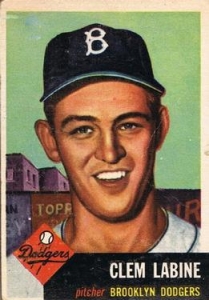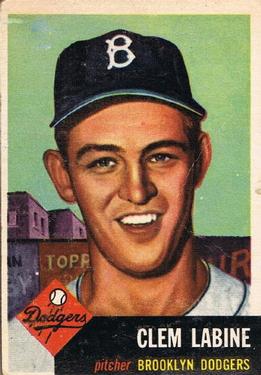July 4, 1955: Clem Labine’s pitching and home run seal Dodgers’ sweep of Phillies
 “Clem Labine was one of the main reasons the Dodgers won it all in 1955. He had the heart of a lion and the intelligence of a wily fox.” – Vin Scully1
“Clem Labine was one of the main reasons the Dodgers won it all in 1955. He had the heart of a lion and the intelligence of a wily fox.” – Vin Scully1
By definition, the relief pitcher is “a substitute pitcher who enters the game, often in a critical situation, to take over for the starting pitcher or another relief pitcher.”2 By role, they have evolved dramatically over baseball’s last century to include middle relievers, long relievers, left-handed specialists, set-up men and closers. By nature, Clem Labine, the relief pitcher, was a practical man. “Relief pitching isn’t glamorous. Kids don’t imitate pinch-hitters and kids don’t imitate relief pitchers. But I’ve come to realize that a starting pitcher, to get to the point where he’s making as much money as I’m making now has to figure on winning 20 games a season.”3
As a relief pitcher, Labine’s numbers tell part of his story, 81 saves over the years with the Dodgers (1950-1960). He led the National League in saves in 1956 (19) and 1957 (17) in an era when complete games by starters were still revered and saves only became an official statistic of major league baseball in 1969. A photo on the cover of a 1957 issue of Sports Illustrated, “King of the Bullpen, Clem Labine,”4 speaks to his success.
But there was another side to Clem Labine, that of a starting pitcher. Although Labine pitched two innings in one game for the Dodgers one year earlier, the 1951 season was considered his rookie one. His performance – 5-1, 2.20 ERA, in 14 games, six starts, five complete games, and two shutouts – earned the 24-year old third place in the National League Rookie of the Year voting, won by Willie Mays. The Dodgers lost the first game of the best-of-three playoff with the New York Giants, and faced the prospect of elimination in the second game at the Polo Grounds. Dodgers manager Charlie Dressen called on Labine to start the game and he delivered a six-hit, complete-game shutout against that pressure in a 10-0 Dodgers win. In his New York Times column, Sports of the Times, Arthur Daley attributed Labine’s success to 23 parachute jumps in over two years in the European theater in World War II, leaving him immune to fear.5
Everyone knows what happened the very next day at the Polo Grounds when Bobby Thomson came to bat in the bottom of the ninth inning.6 Ralph Branca, Carl Erskine, and Labine had all been throwing in the Dodgers bullpen. Dressen chose Branca to replace Don Newcombe on the mound. Later, Labine shared candidly, “But you don’t think I wanted that spot, do you? Nobody wants a spot like that.”7 The words of a frustrated starting pitcher? Branca observed of his teammate, “He also had courage. He really welcomed the challenge of being a reliever. He was a tough bird who loved to be in a crucial spot.”8
Let’s fast-forward to the 1955 season. Why 1955? Labine was well on his way to establishing himself as a premier reliever in the National League and admitted his sentiments about pitching, “But until last year [1955] I was a frustrated starter.”9 He took the mound 60 times that season, more than any other pitcher in major-league baseball.
Now there was the matter of another starting assignment from Dodgers manager Walter Alston to finish off the Phillies in the second game of a holiday doubleheader at Connie Mack Stadium. The opening game of the doubleheader was no contest after the first inning with the Dodgers winning 11-2. Don Newcombe shut out the Phillies over the last eight innings to win his 14th game on the way to another 20-victory season (20-5). The Dodgers hit four home runs, two by Duke Snider, his 26th and 27th of the season, and one each by Gil Hodges and Carl Furillo.
Herm Wehmeier (5-5, 4.19 ERA) yielded the game’s first run in the top of the first inning on Pee Wee Reese’s double and Duke Snider’s single. Labine’s (6-2, 3.39 ERA) start was not an encouraging sign. Richie Ashburn opened the first with a line-drive double and scored immediately on Glen Gorbous’s first-pitch single. When Willie Jones hit a two-run homer, the Phillies had an early 3-1 lead.
Furillo matched his first-game homer with a solo one off Wehmeier on the first pitch in the fourth. When Labine came to bat with two outs, he had a paltry .068 career batting average, 8-for-118. In fact, his only hit so far this season in a 1-for-17 start was a career-first home run in early May against Larry Jackson that helped the Dodgers beat the Cardinals 4-3 at Ebbets Field.10 Make that a second home run for Labine and a tie game at 3-3.
Labine’s inexplicable fourth-inning power coincided with an outstanding pitching performance over the last six innings – one hit and eight groundball outs against Labine’s devastating sinker. Wehmeier managed to match Labine until the Dodgers batted in the eighth. Reese opened with a double and advanced to third on Wehmeier’s wild pitch. The Phillies chose to intentionally walk Snider and pitch to Hodges. Hodges nearly got his second three-run homer of the day, hitting the left-field pavilion wall for a two-run triple.11 Jack Meyer replaced Wehmeier on the mound and Sandy Amorós followed with a sacrifice fly to finish the scoring at 6-3. The sweep gave the Dodgers an imposing 55-22 record, 12½ games ahead of the second-place Chicago Cubs.
Writing for The Sporting News after the game, Dick Young, the brash and always direct sportswriter for the New York Daily News, reminded us again of another era on the mound as well as in the press box. “To while away the time during the long Independence Day doubleheader, the boys in the Philly press box got up a pool on which inning Clem Labine would be knocked out. Clem hadn’t finished a game since the ’51 playoff, and this was his twenty-fourth shot at it. Each writer chipped in two bits and a drew a slip out of a hat. No consideration was given to the possibility that Clem might go the distance. Sure enough, he did, and a big argument raged over the disposition of the $2.25. Finally, one of the newsmen said: ‘Give it to Labine!’”12
The Dodgers’ lead for the remainder of the season was always double digits; they finished 98-55, 13½ games ahead of the Milwaukee Braves, and Labine played a big role. After two starts in late July, Labine dominated in relief, 4-1 with nine saves and a 1.17 ERA in 30 appearances. An .075 career hitter, he hit another home run in September at Wrigley Field, making it three home runs for the season, the only three he ever hit.
The season’s story continued into another World Series for the Dodgers against the Yankees. Having already pitched two scoreless innings of relief in Games One and Two, Labine entered Game Four in the fifth inning in relief of Don Bessent with the Dodgers leading 4-3, two outs, and Yankees at every base. He retired Joe Collins on a groundball to end that threat. After watching Snider hit a three-run homer in the fifth, Labine yielded two runs in the sixth inning, but only a single walk over the last three innings for his first World Series win. In Game Five, Labine replaced Roger Craig on the mound in the seventh inning with the Dodgers leading 4-2 and Elston Howard on first. A groundball double play ended that threat. Labine did yield a solo home run to Yogi Berra in the eighth, but he got the save in the 5-3 Dodgers win, giving them a 3-2 World Series lead. Thanks to Labine’s win and a save and two pitching gems by Johnny Podres, the World Series ending was different this time. The “Wait ’til Next Year” was finally over for Brooklyn!13
No essay about Clem Labine would be complete without recounting the very last time he took the ball to start a game on the mound at Ebbets Field, Game Six of the 1956 World Series. What pressure! After all, Don Larsen’s perfect game the previous day had given the Yankees a 3-2 World Series lead.14 Labine pitched a masterful 10-inning, 1-0 shutout and the Dodgers tied the World Series when Jackie Robinson’s walk-off single scored Jim Gilliam. Joseph Sheehan of the New York Times described it this way: “A thorough mastery of two pitches, sharp control and ice-water temperament make Labine the effective clutch performer he is.”15 He was, indeed, one of The Boys of Summer.16
Sources
The author accessed Baseball-Reference.com for box scores/play-by-play information (baseball-reference.com/boxes/PHI/PHI195507042.shtml) and other data, as well as Retrosheet.org (retrosheet.org/boxesetc/1955/B07042PHI1955.htm). The Clem Labine baseball card illustrated in this essay was issued in 1953 by Topps.
Notes
1 Steve Henson, “Clem Labine, 80; Former Dodgers Relief Pitcher Played in 5 World Series,” Los Angeles Times, March 3, 2007: B13.
2 Paul Dickson, The Dickson Baseball Dictionary, 3rd Edition (New York: W.W. Norton & Company, 2009), 699.
3 Robert Creamer, “Darlin’ Clem Labine,” Sports Illustrated, June 3, 1957: 54-58, vault.si.com/vault/1957/06/03/darlin-clem-labine.
4 “King of the Bullpen, Clem Labine,” Sports Illustrated, June 3, 1957, vault.si.com/vault/1957/06/03/42605-toc.
5 Arthur Daley, “Still a Dead Heat,” New York Times, October 3, 1951: 44.
6 Scott Ferkovich, “October 3, 1951: The Giants Win the Pennant!” SABR Baseball Games Project.
7 Louis D. Rubin Jr., The Quotable Baseball Fanatic (Guilford, Connecticut: The Lyons Press, 2000), 66.
8 Harold Uhlman, “Clem Labine – One of a Kind,” LADodgertalk.com, October 11, 2019, ladodgertalk.com/2019/10/11/clem-labine-one-of-a-kind/.
9 Charles Dexter, “Here’s Why Clem Labine’s Brooklyn’s Key Pitcher, Baseball Digest, June 1956: 5.
10 “Clem Labine took over in the second and later amazed everybody, including himself, by belting his first major league homer deep into the left field stands.” (Roscoe McGowen, “Eighth-Inning Run Trips St. Louis, 4-3,” New York Times, May 6, 1955: 26) McGowen also noted that Labine had struck out six straight times before that home run. The Dodgers had a number of good hitting pitchers, but Labine wasn’t among them. For example, Don Newcombe started the day batting .414 for the season, 24-for-58, with five home runs.
11 John Drebinger, “Brooks’ Long Hits Decisive, 11-2, 6-3, New York Times, July 5, 2020: 38.
12 Dick Young, “Clubhouse Confidential,” The Sporting News, July 13, 1955: 20.
13 Steven C. Weiner, “October 4, 1955: Brooklyn Dodgers Win First World Series as ‘Next Year’ Finally Arrives,” SABR Baseball Games Project.
14 Charles F. Faber, “October 8, 1956: Don Larsen Throws a Perfect Game in the World Series,” SABR Baseball Games Project.
15 Joseph M. Sheehan, “Frequent-Appearing Brook Star Seen Once Too Often by Losers,” New York Times, October 10, 1956: 51.
16 Roger Kahn, The Boys of Summer (New York: Harper, 1972), 209-223.
Additional Stats
Brooklyn Dodgers 6
Philadelphia Phillies 3
Connie Mack Stadium
Philadelphia, PA
Box Score + PBP:
Corrections? Additions?
If you can help us improve this game story, contact us.


